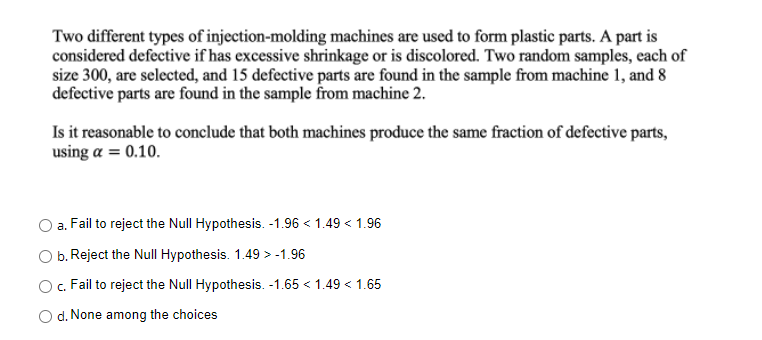Two different types of injection-molding machines are used to form plastic parts. A part is considered defective if has excessive shrinkage or is discolored. Two random samples, each of size 300, are selected, and 15 defective parts are found in the sample from machine 1, and 8 defective parts are found in the sample from machine 2. Is it reasonable to conclude that both machines produce the same fraction of defective parts, using a = 0.10. O a. Fail to reject the Null Hypothesis. -1.96 < 1.49 < 1.96 b. Reject the Null Hypothesis. 1.49> -1.96 O c. Fail to reject the Null Hypothesis. -1.65 < 1.49 < 1.65 O d. None among the choices
Two different types of injection-molding machines are used to form plastic parts. A part is considered defective if has excessive shrinkage or is discolored. Two random samples, each of size 300, are selected, and 15 defective parts are found in the sample from machine 1, and 8 defective parts are found in the sample from machine 2. Is it reasonable to conclude that both machines produce the same fraction of defective parts, using a = 0.10. O a. Fail to reject the Null Hypothesis. -1.96 < 1.49 < 1.96 b. Reject the Null Hypothesis. 1.49> -1.96 O c. Fail to reject the Null Hypothesis. -1.65 < 1.49 < 1.65 O d. None among the choices
Algebra & Trigonometry with Analytic Geometry
13th Edition
ISBN:9781133382119
Author:Swokowski
Publisher:Swokowski
Chapter10: Sequences, Series, And Probability
Section10.8: Probability
Problem 32E
Related questions
Question

Transcribed Image Text:Two different types of injection-molding machines are used to form plastic parts. A part is
considered defective if has excessive shrinkage or is discolored. Two random samples, each of
size 300, are selected, and 15 defective parts are found in the sample from machine 1, and 8
defective parts are found in the sample from machine 2.
Is it reasonable to conclude that both machines produce the same fraction of defective parts,
using a = 0.10.
a.
Fail to reject the Null Hypothesis. -1.96 < 1.49 < 1.96
b. Reject the Null Hypothesis. 1.49 > -1.96
c. Fail to reject the Null Hypothesis. -1.65 < 1.49 < 1.65
O d. None among the choices
Expert Solution
This question has been solved!
Explore an expertly crafted, step-by-step solution for a thorough understanding of key concepts.
This is a popular solution!
Trending now
This is a popular solution!
Step by step
Solved in 2 steps with 2 images

Recommended textbooks for you

Algebra & Trigonometry with Analytic Geometry
Algebra
ISBN:
9781133382119
Author:
Swokowski
Publisher:
Cengage

Holt Mcdougal Larson Pre-algebra: Student Edition…
Algebra
ISBN:
9780547587776
Author:
HOLT MCDOUGAL
Publisher:
HOLT MCDOUGAL

Algebra & Trigonometry with Analytic Geometry
Algebra
ISBN:
9781133382119
Author:
Swokowski
Publisher:
Cengage

Holt Mcdougal Larson Pre-algebra: Student Edition…
Algebra
ISBN:
9780547587776
Author:
HOLT MCDOUGAL
Publisher:
HOLT MCDOUGAL